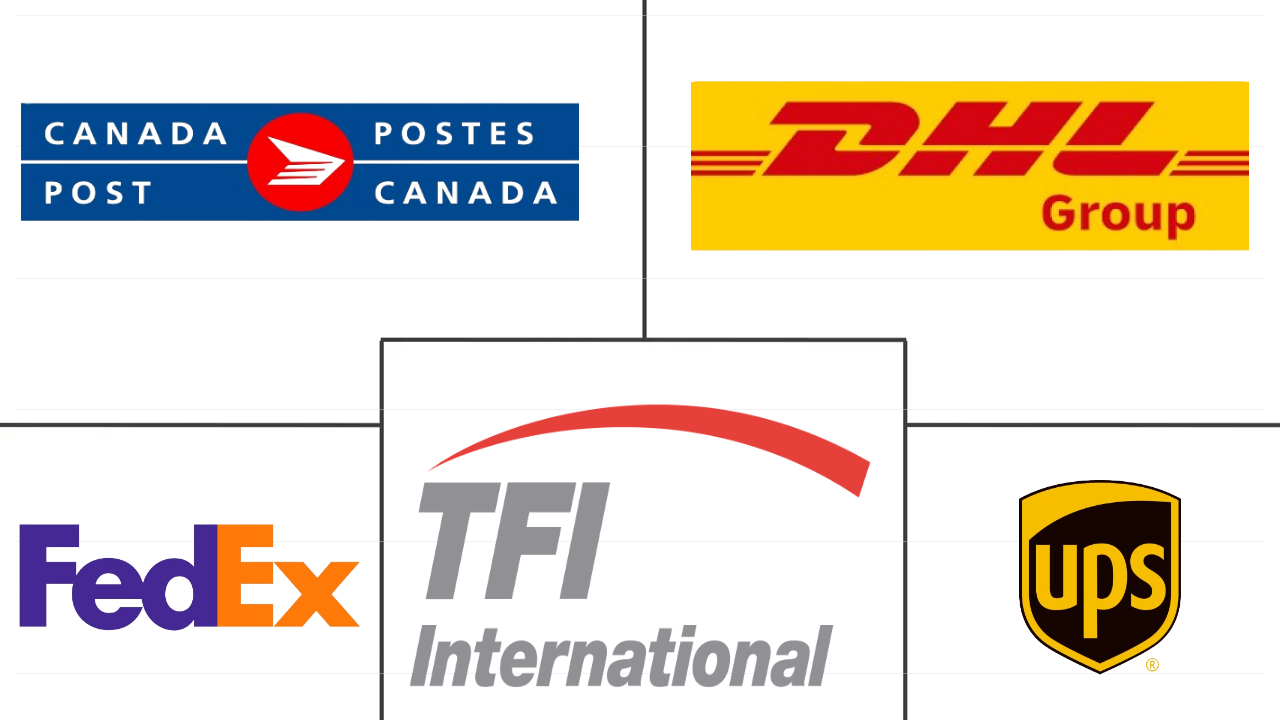Market Size of canada courier, express, and parcel (cep) Industry
| Icons | Lable | Value |
|---|---|---|
|
|
Study Period | 2017 - 2030 |
|
|
Market Size (2024) | USD 16.46 Billion |
|
|
Market Size (2030) | USD 22.40 Billion |
|
|
Largest Share by Destination | Domestic |
|
|
CAGR (2024 - 2030) | 5.27 % |
|
|
Fastest Growing by Destination | International |
|
|
Market Concentration | Medium |
Major Players |
||

|
||
|
*Disclaimer: Major Players sorted in no particular order |
Canada Courier, Express, and Parcel (CEP) Market Analysis
The Canada Courier, Express, and Parcel (CEP) Market size is estimated at 16.46 billion USD in 2024, and is expected to reach 22.40 billion USD by 2030, growing at a CAGR of 5.27% during the forecast period (2024-2030).
16.46 Billion
Market Size in 2024 (USD)
22.40 Billion
Market Size in 2030 (USD)
3.85 %
CAGR (2017-2023)
5.27 %
CAGR (2024-2030)
Fastest Growing Market by Speed of Delivery
5.95 %
Projected CAGR, Express, 2024-2030
The demand for express shipping is significantly increasing, and leading e-commerce companies are moving to meet this demand via strategic initiatives and partnerships.
Fastest Growing Market by Model
6.85 %
Projected CAGR, Business-to-Consumer (B2C), 2024-2030
Demand for fashion items, children's toys, electronics, and furniture goods via retail e-commerce under the B2C segment is the major growth driver of the segment.
Largest Market by Shipment Weight
50.87 %
value share, Light Weight Shipments, 2023
Fashion, apparel, and personal healthcare products are the major goods driving the demand in and growth of the segment.
Largest Market by End User Industry
35.80 %
value share, E-Commerce, 2023
Canadians have adopted e-commerce amid a major disruption in retail channels, making it the largest driver for delivery demand.
First Leading Market Player
18.02 %
market share, Canada Post, 2022

Canada Post delivers over 6.7 billion mail, parcel, and messages to more than 17 million addresses in Canada. It operates with around 5,900 post offices across the country.
E-commerce and international trade are boosting CEP growth in Canada
- Overall, CEP value in Canada increased by about 6.34% YoY in 2022 with aim to rise even further in coming years. Following the growth trend, in June 2023, FedEx Corp. initiated plans to merge its FedEx Express and Ground operations in Canada, making Canada the first FedEx country where the two operations will be fully unified. The combination will occur in phases, starting in April 2024 and finishing around the 2024 peak season. Under the structure, FedEx Express will manage the operation and handle all the local pickup and delivery. FedEx Ground, will provide the middle-mile line-haul operation. The operation will be called FedEx Express Canada.
- Canadian customers made USD 861 billion worth of online purchases from US-based merchants in 2020, a 44% rise over the 15.1% YoY gain in 2019. Re-opening of the economy post-pandemic led to an increased demand, which led to an increase in e-commerce users, with 27 million users as of March 2022, thus boosting the international CEP market.
- Canada was also the top trading partner of the United States in 2022, wherein Canada's total trade with the country increased 5% YoY, touching USD 63.4 billion in November 2022. The first ten months of 2022 yielded a trade between the two countries amounting to USD 733 billion. Commodities not elsewhere specified, with imports worth USD 1.67 billion and motor vehicle parts and accessories worth USD 1.5 billion, were some of Canada's main imports from the United States in November 2022. These factors mainly drove the international CEP market growth during the period. Drone deliveries are also rapidly growing in Canada to meet the growing demands of the domestic CEP market, wherein the commercial drone market is expected to grow by more than 17% by 2027.
Canada Courier, Express, and Parcel (CEP) Industry Segmentation
Domestic, International are covered as segments by Destination. Express, Non-Express are covered as segments by Speed Of Delivery. Business-to-Business (B2B), Business-to-Consumer (B2C), Consumer-to-Consumer (C2C) are covered as segments by Model. Heavy Weight Shipments, Light Weight Shipments, Medium Weight Shipments are covered as segments by Shipment Weight. Air, Road, Others are covered as segments by Mode Of Transport. E-Commerce, Financial Services (BFSI), Healthcare, Manufacturing, Primary Industry, Wholesale and Retail Trade (Offline), Others are covered as segments by End User Industry.
- Overall, CEP value in Canada increased by about 6.34% YoY in 2022 with aim to rise even further in coming years. Following the growth trend, in June 2023, FedEx Corp. initiated plans to merge its FedEx Express and Ground operations in Canada, making Canada the first FedEx country where the two operations will be fully unified. The combination will occur in phases, starting in April 2024 and finishing around the 2024 peak season. Under the structure, FedEx Express will manage the operation and handle all the local pickup and delivery. FedEx Ground, will provide the middle-mile line-haul operation. The operation will be called FedEx Express Canada.
- Canadian customers made USD 861 billion worth of online purchases from US-based merchants in 2020, a 44% rise over the 15.1% YoY gain in 2019. Re-opening of the economy post-pandemic led to an increased demand, which led to an increase in e-commerce users, with 27 million users as of March 2022, thus boosting the international CEP market.
- Canada was also the top trading partner of the United States in 2022, wherein Canada's total trade with the country increased 5% YoY, touching USD 63.4 billion in November 2022. The first ten months of 2022 yielded a trade between the two countries amounting to USD 733 billion. Commodities not elsewhere specified, with imports worth USD 1.67 billion and motor vehicle parts and accessories worth USD 1.5 billion, were some of Canada's main imports from the United States in November 2022. These factors mainly drove the international CEP market growth during the period. Drone deliveries are also rapidly growing in Canada to meet the growing demands of the domestic CEP market, wherein the commercial drone market is expected to grow by more than 17% by 2027.
| Destination | |
| Domestic | |
| International |
| Speed Of Delivery | |
| Express | |
| Non-Express |
| Model | |
| Business-to-Business (B2B) | |
| Business-to-Consumer (B2C) | |
| Consumer-to-Consumer (C2C) |
| Shipment Weight | |
| Heavy Weight Shipments | |
| Light Weight Shipments | |
| Medium Weight Shipments |
| Mode Of Transport | |
| Air | |
| Road | |
| Others |
| End User Industry | |
| E-Commerce | |
| Financial Services (BFSI) | |
| Healthcare | |
| Manufacturing | |
| Primary Industry | |
| Wholesale and Retail Trade (Offline) | |
| Others |
Canada Courier, Express, and Parcel (CEP) Market Size Summary
The Canada Courier, Express, and Parcel (CEP) market is experiencing a robust expansion, driven by the resurgence of e-commerce and strategic industry consolidations. The market is characterized by a moderate level of consolidation, with major players such as Canada Post, DHL Group, FedEx, TFI International Inc., and United Parcel Service of America, Inc. holding significant market shares. Recent developments, such as FedEx's decision to merge its Express and Ground operations in Canada, highlight the industry's focus on enhancing operational efficiency and service delivery. The growth trajectory is further supported by increasing online purchases and Canada's strong trade relations with the United States, which have bolstered the demand for CEP services. The government's investment in transportation infrastructure and the rapid adoption of drone deliveries are also contributing to the market's expansion, ensuring that Canada remains well-connected and capable of meeting the growing logistical demands.
The market's growth is underscored by the significant contributions of the transportation and storage sector to Canada's GDP, with substantial investments aimed at improving transportation networks and facilities. These investments are crucial for supporting internal trade and enhancing the resilience of the Canadian economy. However, the market faces challenges such as fluctuating fuel prices, which impact operational costs for trucking companies. Despite these challenges, the CEP market is poised for continued growth, with innovations and strategic partnerships playing a key role in shaping its future. The ongoing developments in the sector, including partnerships and acquisitions by major players, are expected to further strengthen the market's position and drive its expansion in the coming years.
Canada Courier, Express, and Parcel (CEP) Market Size - Table of Contents
-
1. MARKET SEGMENTATION (includes Market Value in USD, Forecasts up to 2030 and analysis of growth prospects)
-
1.1 Destination
-
1.1.1 Domestic
-
1.1.2 International
-
-
1.2 Speed Of Delivery
-
1.2.1 Express
-
1.2.2 Non-Express
-
-
1.3 Model
-
1.3.1 Business-to-Business (B2B)
-
1.3.2 Business-to-Consumer (B2C)
-
1.3.3 Consumer-to-Consumer (C2C)
-
-
1.4 Shipment Weight
-
1.4.1 Heavy Weight Shipments
-
1.4.2 Light Weight Shipments
-
1.4.3 Medium Weight Shipments
-
-
1.5 Mode Of Transport
-
1.5.1 Air
-
1.5.2 Road
-
1.5.3 Others
-
-
1.6 End User Industry
-
1.6.1 E-Commerce
-
1.6.2 Financial Services (BFSI)
-
1.6.3 Healthcare
-
1.6.4 Manufacturing
-
1.6.5 Primary Industry
-
1.6.6 Wholesale and Retail Trade (Offline)
-
1.6.7 Others
-
-
Canada Courier, Express, and Parcel (CEP) Market Size FAQs
How big is the Canada Courier, Express, and Parcel (CEP) Market?
The Canada Courier, Express, and Parcel (CEP) Market size is expected to reach USD 16.46 billion in 2024 and grow at a CAGR of 5.27% to reach USD 22.40 billion by 2030.
What is the current Canada Courier, Express, and Parcel (CEP) Market size?
In 2024, the Canada Courier, Express, and Parcel (CEP) Market size is expected to reach USD 16.46 billion.

